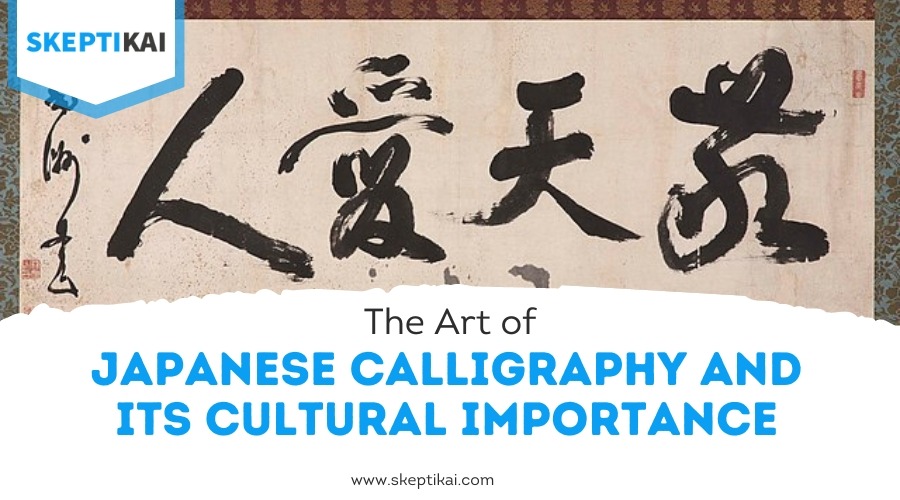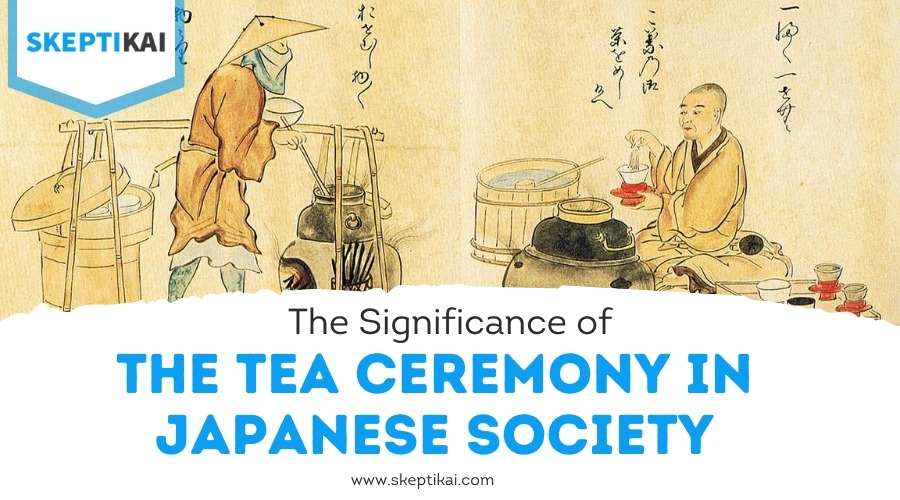How Old Is Japanese Culture?
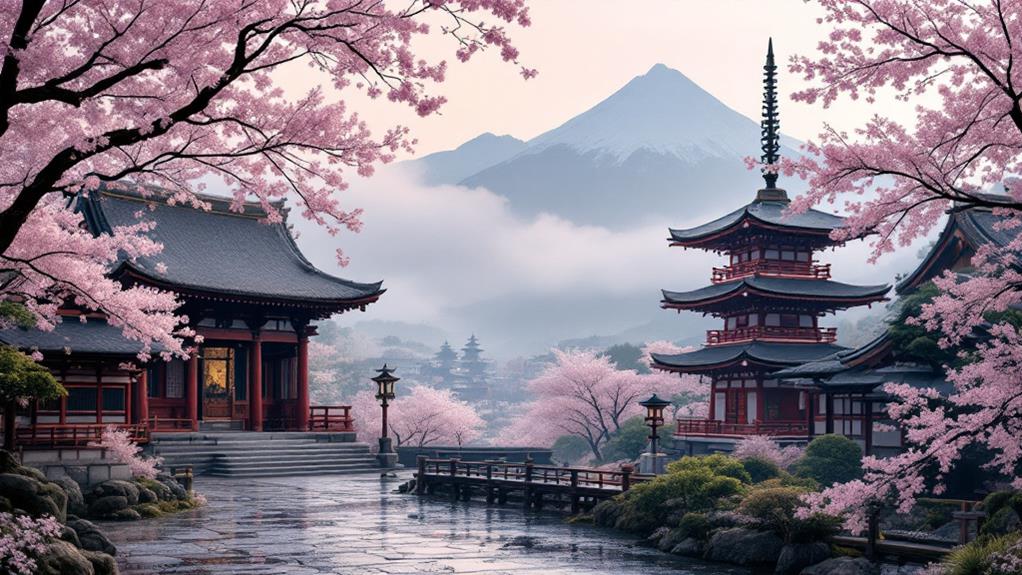
Japanese culture is an ancient tapestry dating back over 16,000 years, beginning with the Jomon Period (14,000 BCE - 300 BCE). During this time, the Japanese people were hunters, gatherers, and skilled pottery makers. This was the dawn of intricate cultural practices that continued to evolve through the Yayoi, Asuka, and Nara periods with the introduction of agriculture, Buddhism, and literature. Over centuries, refinement during the Heian period and the rise of the samurai shaped societal values. Even throughout isolation and industrial transformation, traditional craftsmanship thrived, making Japanese culture rich and diverse. There's so much more to uncover.
Jomon Period Beginnings
The Jomon Period, dating back to around 14,000 BCE, marks the dawn of Japanese culture. Imagine living in a time where Jomon pottery, characterized by its intricate cord-marked patterns, plays a crucial role in daily life. You'd find yourself engaged in a Jomon lifestyle that revolves around hunting, gathering, and fishing—a subsistence strategy that sustained them for thousands of years. The society, though simple, was rich in Jomon spirituality, evident in their art and the ceremonial objects they crafted. As society evolved, the extended family model would play a significant role in social organization, mirroring the collective practices of later periods. As you investigate further, you'll notice the Jomon society wasn't isolated. Evidence of Jomon trade with neighboring regions shows they exchanged goods, hinting at a network of cultural interactions. Their technology, though primitive by today's standards, was quite advanced for their time. Jomon tools, made from stone and bone, were crucial for their survival and daily activities. You'd also encounter their unique burial practices, offering insights into their beliefs about life and death. Jomon art, encompassing figurines and pottery, reveals much about their worldviews and rituals. By studying this period, you gain a deeper understanding of the roots of Japanese culture and its enduring legacy.
Yayoi Cultural Developments
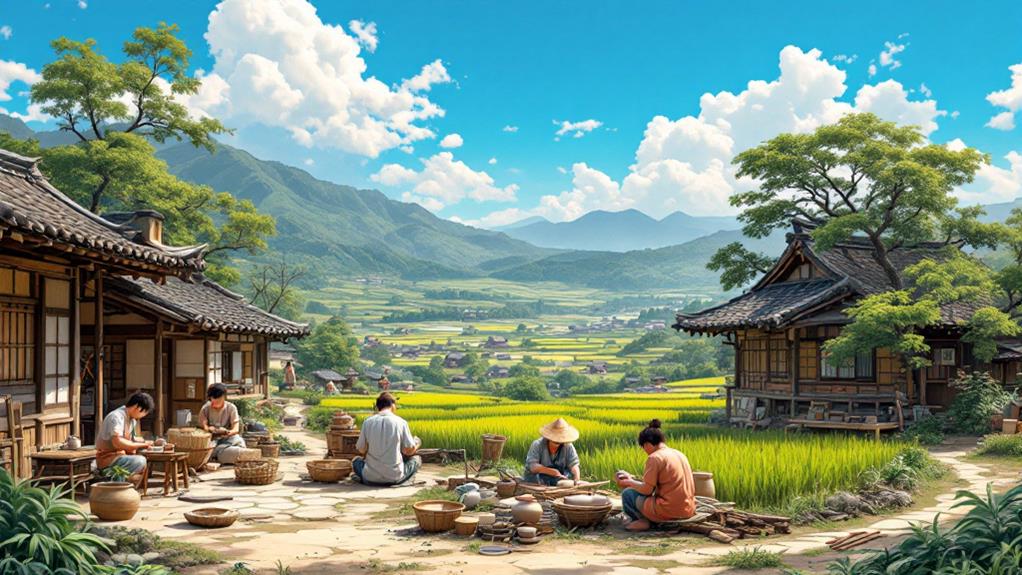
Often seen as a transformative period, the Yayoi Period, which began around 300 BCE, ushered in considerable cultural advancements in Japan. You'll notice that yayoi agriculture marked a turning point with the introduction of wet-rice farming, enhancing food production and population growth. This agricultural shift influenced yayoi settlement patterns, leading to more permanent and larger villages. The emphasis on community collaboration during this period is evident in the collective efforts to manage and distribute resources efficiently, laying a foundation for modern societal interactions. Yayoi pottery evolved greatly, displaying more intricate designs compared to the Jomon period, which reflected yayoi artistic expression. These advancements in pottery were not just artistic but also practical, aiding in storage and cooking, which were crucial for sustaining larger communities.
The yayoi social structure became more complex, with evidence of class stratification emerging. This complexity was partly driven by yayoi trade networks, which facilitated the exchange of goods like bronze and iron, introducing yayoi technological advancements. Such advancements further influenced daily life and warfare.
Yayoi spiritual beliefs also evolved, as you might observe in burial practices, indicating a more organized societal hierarchy. These beliefs were often intertwined with yayoi artistic expression, seen in decorative items and ritual artifacts, highlighting a culture rich in both material and spiritual dimensions.
Asuka and Nara Influence
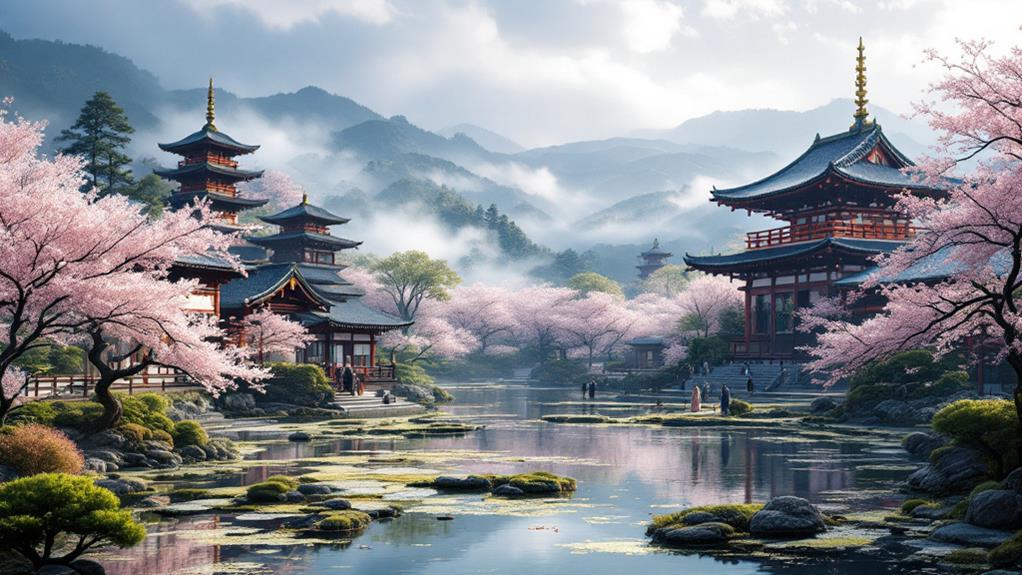
During the Asuka and Nara periods, Japan witnessed significant cultural and political transformations. You'd find that Asuka architecture played an essential role in shaping the visual and spiritual landscape of the time. The introduction of Buddhism from the Korean Peninsula and China brought about the construction of impressive wooden temples. These structures, like the Horyu-ji Temple, stand as a reflection of Asuka architecture's emphasis on symmetry, simplicity, and harmony with nature. As you investigate these architectural marvels, you'll notice how they reflect a blend of native and continental influences, setting the foundation for Japanese religious and cultural identity.
In addition to architecture, Nara literature emerged as an important aspect of cultural expression during this period. You'd encounter texts like the "Kojiki" and "Nihon Shoki," which are some of Japan's earliest written records. These chronicles not only document the creation myths and historical accounts but also illustrate the codification of Shinto beliefs and practices. By immersing yourself in Nara literature, you gain insights into how early Japanese society viewed their world, their gods, and their place in history, marking a significant shift towards a more structured and literate society.
Heian Era Refinement
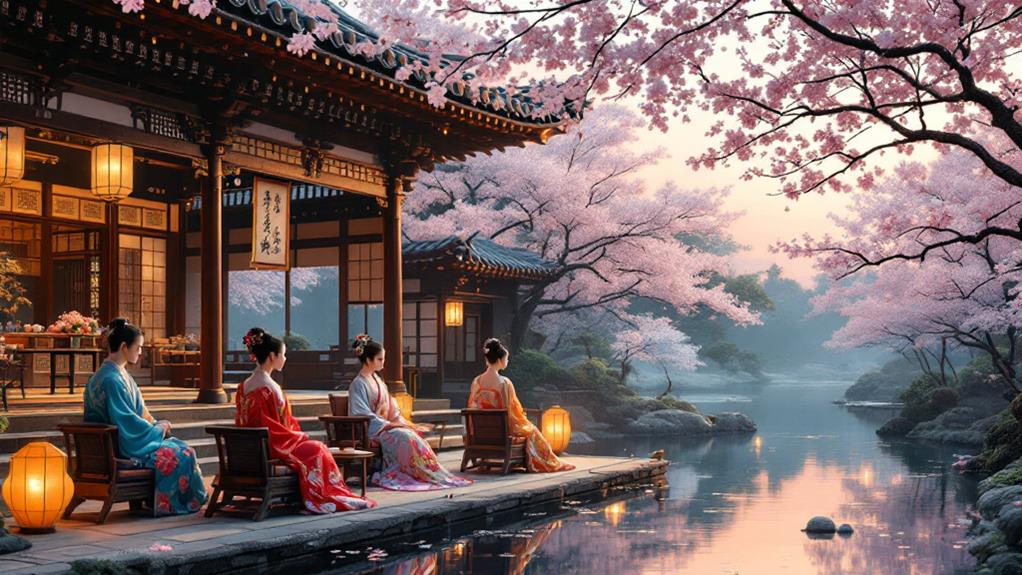
Leaving behind the transformative Asuka and Nara periods, you'll find the Heian age marks a time of unparalleled refinement in Japanese culture. During this time, court aesthetics flourished, as the aristocratic lifestyle welcomed elegance and sophistication. The Heian court became the epicenter of cultural development, where your status depended on your mastery of artistic expressions.
Literary achievements reached new heights, with classics like "The Tale of Genji" illustrating the age's rich storytelling. As you investigate Heian literature, notice the distinct poetry forms, including the tanka, which captured fleeting emotions with precision. Calligraphy techniques evolved alongside these literary pursuits, turning writing into an art form that demanded grace and balance.
Fashion trends during the Heian period were similarly sophisticated. Layered silk robes, known as "jūnihitoe," became symbols of rank and taste. Musical traditions also thrived, with instruments like the koto and biwa providing a soundtrack to courtly life. These cultural elements combined to create a world of refinement, where every detail mattered. By immersing yourself in the Heian age's contributions, you'll appreciate how this period shaped the aesthetics and intellectual pursuits that continue to influence Japanese culture today.
Rise of the Samurai
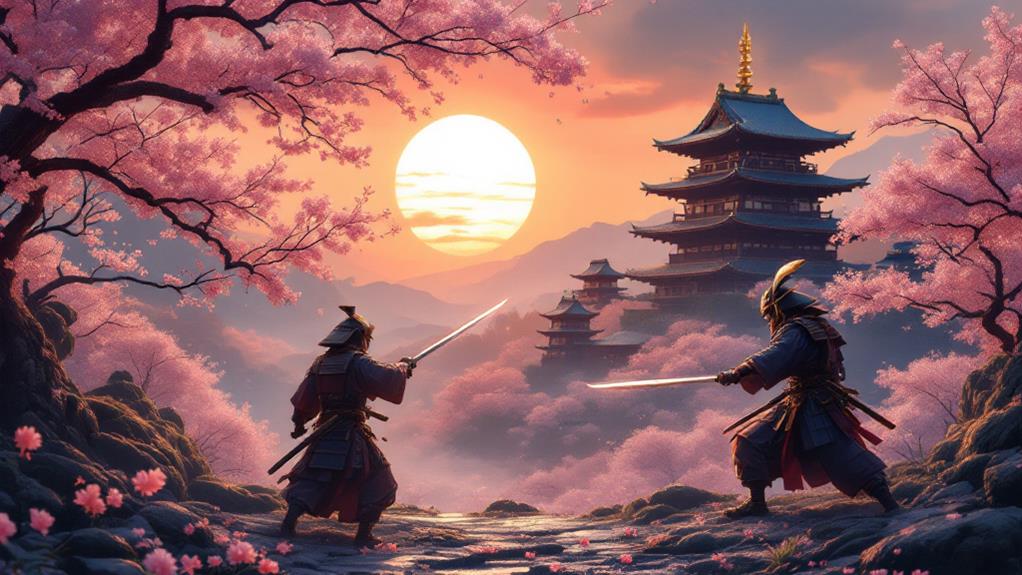
As the Heian period's delicate artistry gave way to a more turbulent period, the rise of the samurai emerged as a defining force in Japanese culture. You can picture the transformation from courtly elegance to robust warrior life. The samurai, known for their formidable skills and unwavering loyalty, became the backbone of feudal Japan. They weren't just fighters; they embodied a unique blend of martial prowess and philosophical depth.
You'll find that the samurai code, known as Bushido, was central to their identity. This code wasn't merely a set of rules; it was a way of life that emphasized honor, loyalty, and bravery. By adhering to these warrior ethics, samurai cultivated a discipline that permeated every aspect of their lives. The commitment to these values wasn't optional—it was crucial.
Imagine living in a world where personal honor was paramount, and every action had to align with this rigorous code. The samurai's influence extended beyond the battlefield, shaping Japanese society and politics. Their values became deeply ingrained in the national ethos, influencing everything from art to governance. Fundamentally, the samurai's legacy is a reflection of the enduring power of principles and discipline.
Edo Period Isolation

The Edo period, known for its sakoku or isolation policy, marked a time when Japan closed its doors to the outside world, barring most foreign influence. Under the Tokugawa Shogunate, this isolation allowed Japan to cultivate a unique cultural identity. You'd find that cultural exchange was limited to a select few, primarily through controlled interactions with China and the Netherlands. Despite this, Japan's internal cultural vibrancy thrived.
The Tokugawa Shogunate's economic policies fostered stability, fostering growth in agriculture and trade within Japan. Urban life flourished, particularly in cities like Edo (now Tokyo), where merchants and artisans thrived under a strict social hierarchy. This hierarchy, however, guaranteed that samurai maintained their status above commoners, impacting everyday life considerably.
Art development saw a surge, with Ukiyo-e prints and Kabuki theater becoming popular forms of entertainment. These were reflections of the period's tastes and values, largely free from foreign intervention. Simultaneously, traditional religious practices, including Shinto and Buddhism, were preserved and adapted to fit the societal norms of the time.
Foreign relations were minimal, with only limited contact allowed, guaranteeing minimal external influence on Japan's evolving cultural tapestry.
Meiji Restoration Changes
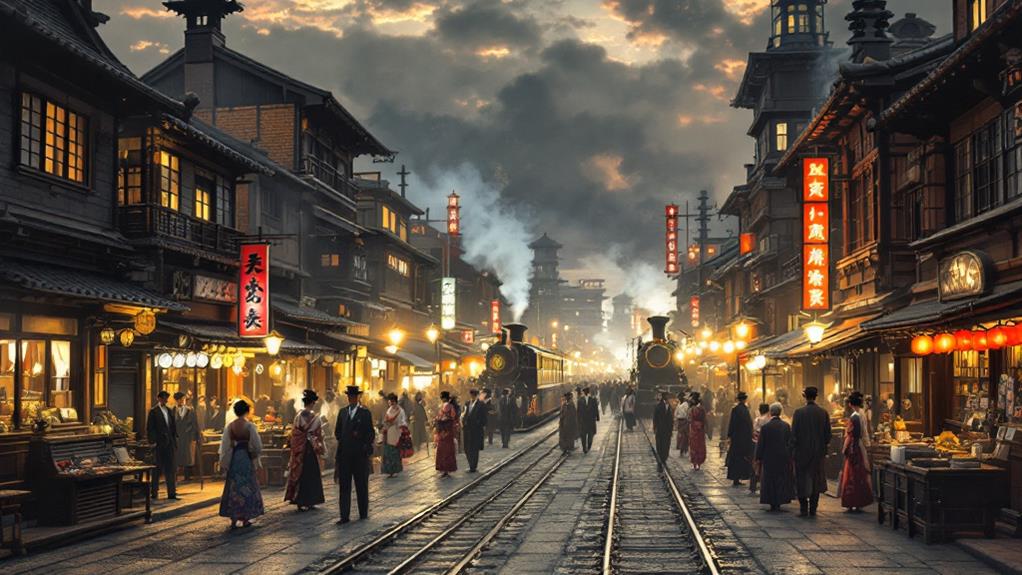
Stepping into the Meiji Restoration, you witness Japan's dramatic shift from isolation to rapid modernization. This period marks a transformative phase where Japan adopts Western influences to reshape its society, economy, and culture. The Meiji government actively pursues Meiji modernization by adopting Western technology and ideas to strengthen Japan's global position.
You'll notice several key changes during this time:
- Industrial advancements: Japan rapidly develops its infrastructure, focusing on railways, telegraphs, and factories, propelling the nation into an industrial powerhouse.
- Educational reform: Western-style education systems are established, fostering a new generation of Japanese scholars and professionals.
- Military modernization: The Japanese military adopts Western tactics and technology, ensuring the nation's defense capabilities are on par with Western powers.
- Cultural exchange: Artists and intellectuals travel abroad, bringing back new ideas and art forms that blend with traditional Japanese culture.
- Political restructuring: The feudal system is abolished, and a constitutional monarchy is established, aligning Japan more closely with Western political models.
These sweeping changes redefine Japan's identity and lay the groundwork for its emergence as a modern nation. Through Meiji modernization and cultural exchange, Japan successfully integrates Western influences while preserving its unique cultural heritage.
Post-War Cultural Shifts
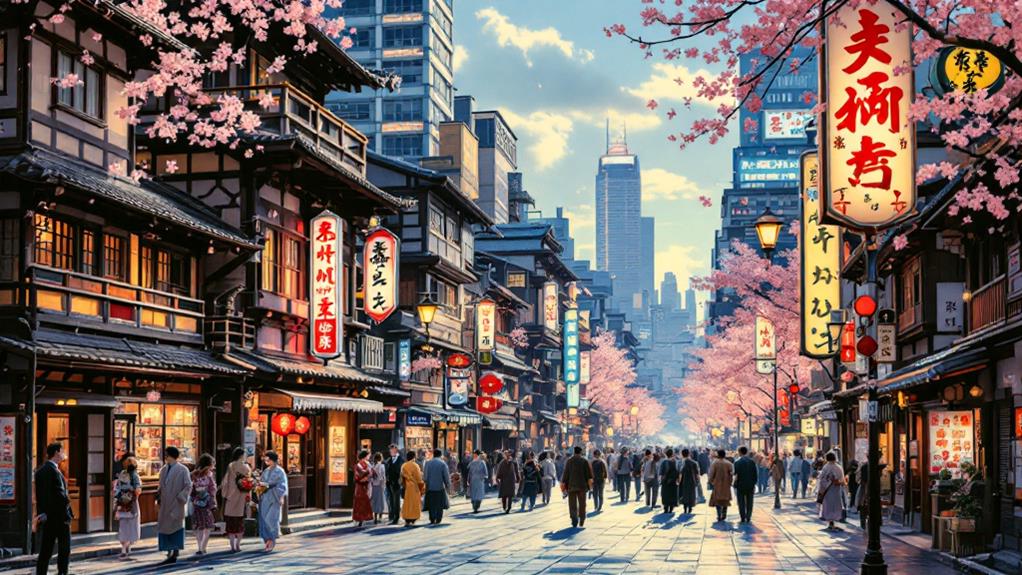
Following World War II, Japan undergoes a remarkable cultural transformation, redefining itself amidst the ashes of conflict. Consumerism trends surge as the economy recovers, fueling a demand for modern conveniences and entertainment. The globalization impact becomes evident as Western influences seep into everyday life, reshaping everything from business practices to social norms.
Technology integration plays a crucial role, enabling Japan to emerge as a leader in electronics and innovation. The traditional arts, however, don't fall by the wayside. Instead, they find new expression, blending with contemporary aesthetics and reaching global audiences. This fusion keeps time-honored practices alive while appealing to modern sensibilities.
Youth culture drives much of this change, adopting new ideas and pushing boundaries in fashion evolution. You see trends like streetwear taking off, blending Western styles with Japanese creativity. Digital media also becomes a powerful force, connecting people across borders and showcasing Japan's unique cultural offerings.
Culinary fusion is another area where shifts are apparent. Traditional Japanese cuisine melds with international flavors, creating dishes that reflect Japan's open acceptance of global influences. This period of transformation sets the stage for a dynamic, evolving cultural landscape.
Modern Cultural Innovations
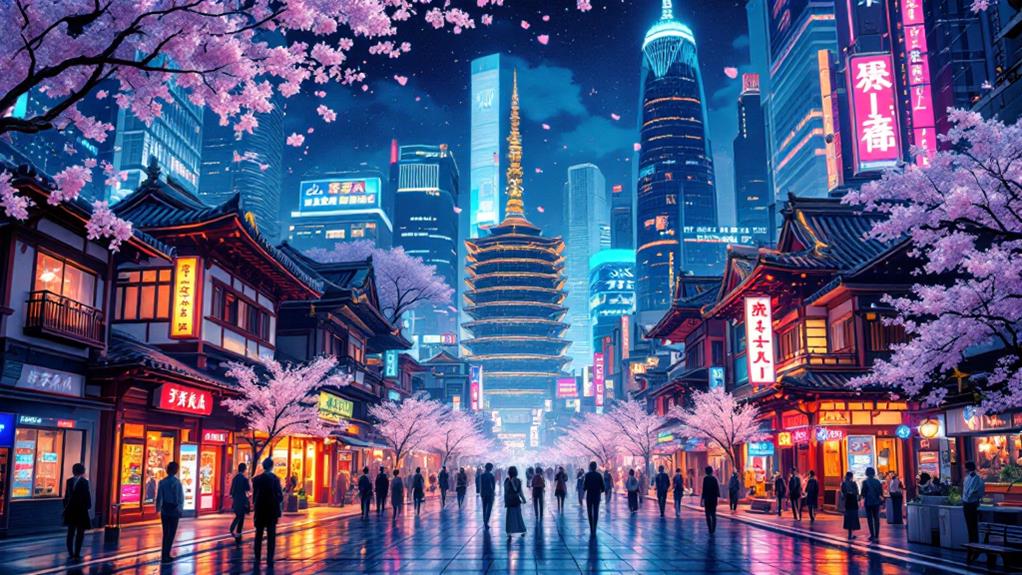
Building on the post-war period's transformative energy, modern Japan continues to innovate culturally, blending tradition with cutting-edge advancements. You're witnessing a fascinating anime evolution, where storytelling and art styles grow more sophisticated, enchanting audiences worldwide. Japanese fashion trends keep pushing boundaries, mixing traditional garments with contemporary designs, influencing global fashion scenes.
In the domain of digital art, Japanese artists are pioneering new techniques, often inspired by anime and manga, which are shared widely through social media platforms. Culinary fusion in Japan creates delightful dishes by combining traditional flavors with international cuisine, making dining a unique experience. Music genres from J-Pop to city pop have exploded in popularity, both in Japan and abroad, showcasing the country's creative versatility.
Consider these key elements of Japanese modern cultural innovations:
- Anime evolution: Globally influential storytelling and art.
- Fashion trends: Blending tradition with avant-garde designs.
- Digital art: Cutting-edge techniques shared on social media.
- Culinary fusion: Traditional flavors meet global influences.
- Music genres: Diverse styles capturing international attention.
Japanese gaming culture also plays a significant role, creating engaging experiences that enthrall players worldwide. Contemporary literature in Japan, meanwhile, offers fresh narratives that reflect modern society's complexities, connecting with readers on a profound level.

